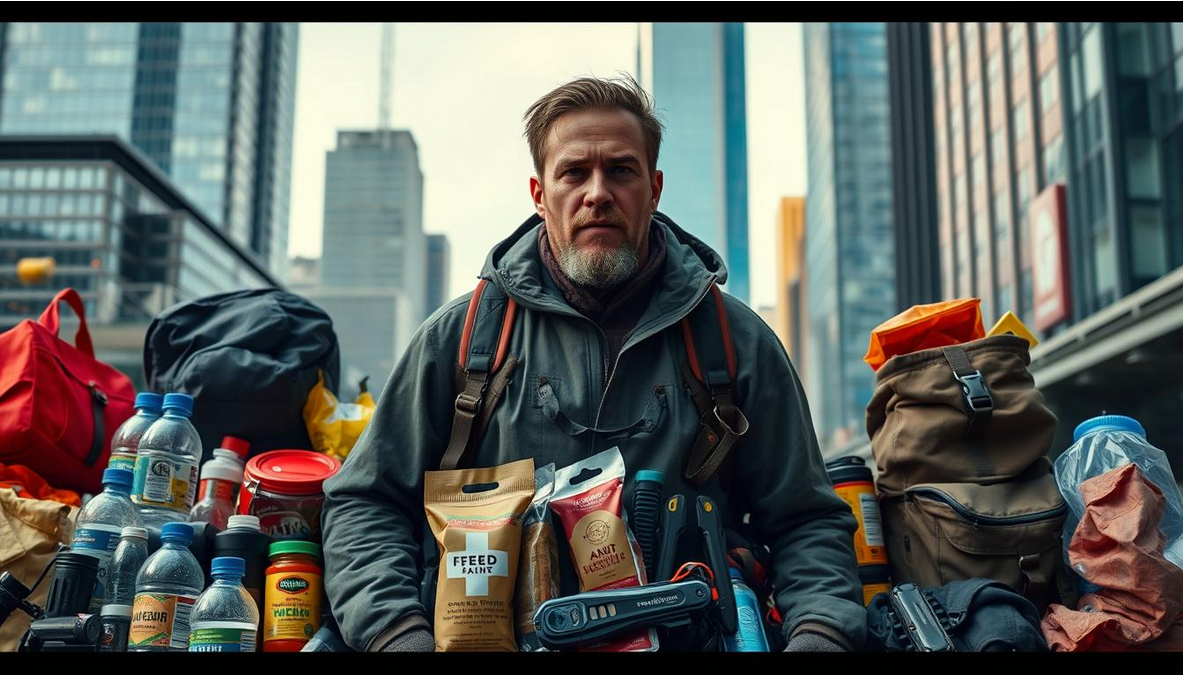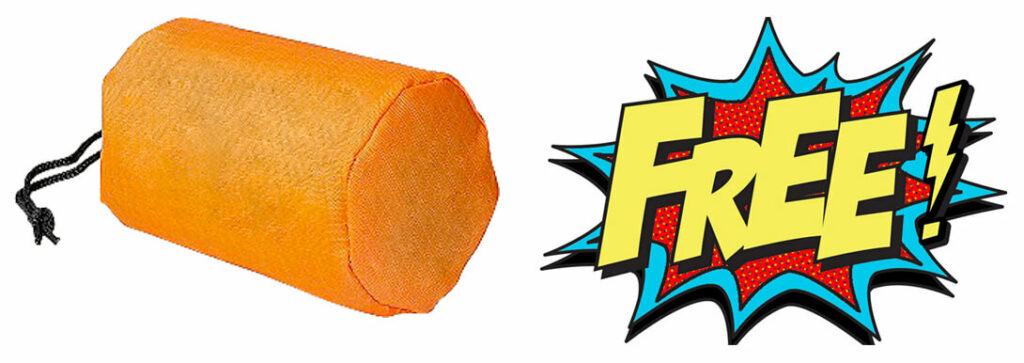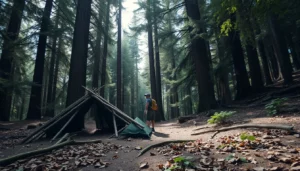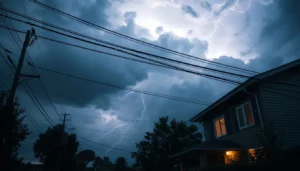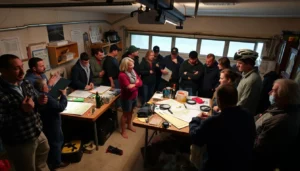Imagine being in a busy city, hearing and seeing everything around you. Then, disaster strikes, like an earthquake or flood, changing everything. In this moment, you might feel lost and scared. But, with the right emergency kit and planning, you can feel safe and strong.
For people living in cities, having a survival kit is crucial. Cities are crowded, making it hard to get what you need in an emergency. A 72-hour emergency kit for city living helps families survive on their own. By packing the right supplies, you can be ready for anything and feel secure.

Protect your home and family in uncertain times!
Before we continue, let me introduce you to Guerilla Home Defense — the ultimate survival guide for navigating the uncertain times ahead.
Covering all three stages of the impending crisis in America, this guide equips you with the tools to protect your home from the surge in crimes like break-ins and attacks, handle the chaos of riots and looting, and even prepare for the potential of civil war.
If you’re serious about staying safe when disaster strikes, Guerilla Home Defense is a must-have resource.
Why You Need a 72-Hour Emergency Kit
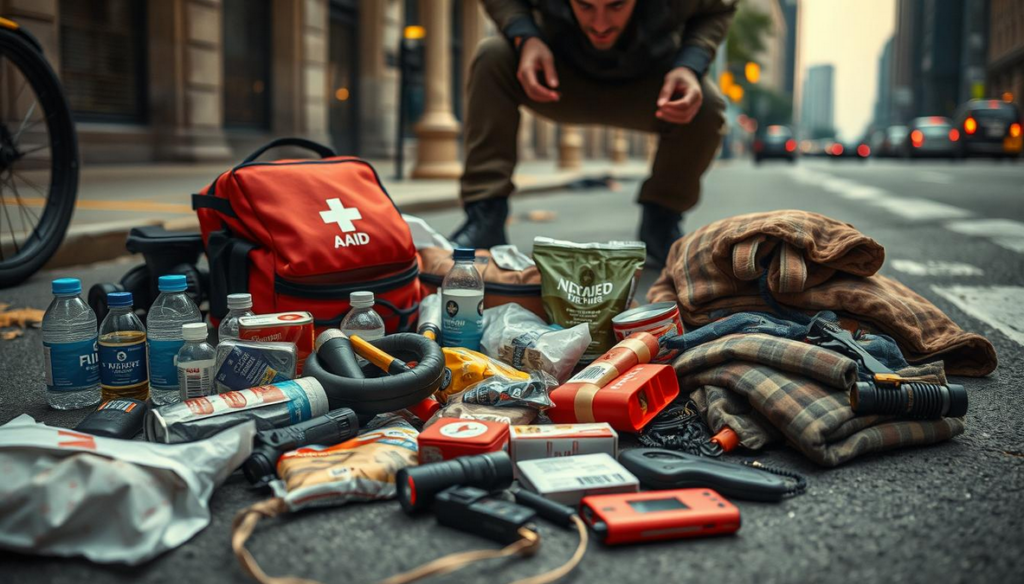
Living in a city can feel like being in a world of constant motion, with access to everything you need at your fingertips.
However, this ease can vanish quickly during emergencies. Urban areas are particularly vulnerable to disruptions, and when disasters hit, they can bring chaos.
Basic services like electricity, water, and public transport can shut down without warning, leaving you without the essentials you rely on daily. This is why having a 72-hour emergency kit is so important. It’s your personal safety net in the first crucial hours after a disaster.
A well-prepared emergency kit gives you the tools and resources to maintain stability in unstable times. It acts as a buffer, allowing you and your family to handle immediate needs, such as food, water, and medical supplies, without waiting for outside help.
Preparing for Disaster Scenarios
Preparing for such disaster scenarios is about more than just having a generic emergency kit; it’s about tailoring your kit to the specific risks associated with city living.
For example, cities often have limited open spaces, so an earthquake could trap you indoors or block your exit routes.
Flooding, meanwhile, can happen fast due to inadequate drainage systems, leading to roadblocks and power outages that make it difficult to navigate or evacuate.
Benefits of being Prepared
When you’re prepared, you’ll feel more in control during emergencies, which helps you make better decisions under pressure.
A 72-hour emergency kit allows you to address immediate needs like food, water, and shelter without panicking or scrambling. This peace of mind is especially crucial for families, as it helps keep everyone calm and focused on staying safe.
In short, having a 72-hour emergency kit not only helps you survive; it gives you the confidence and resources to navigate whatever challenges arise, ensuring your safety and peace of mind.
Emergency Essentials for Your 72-Hour Kit
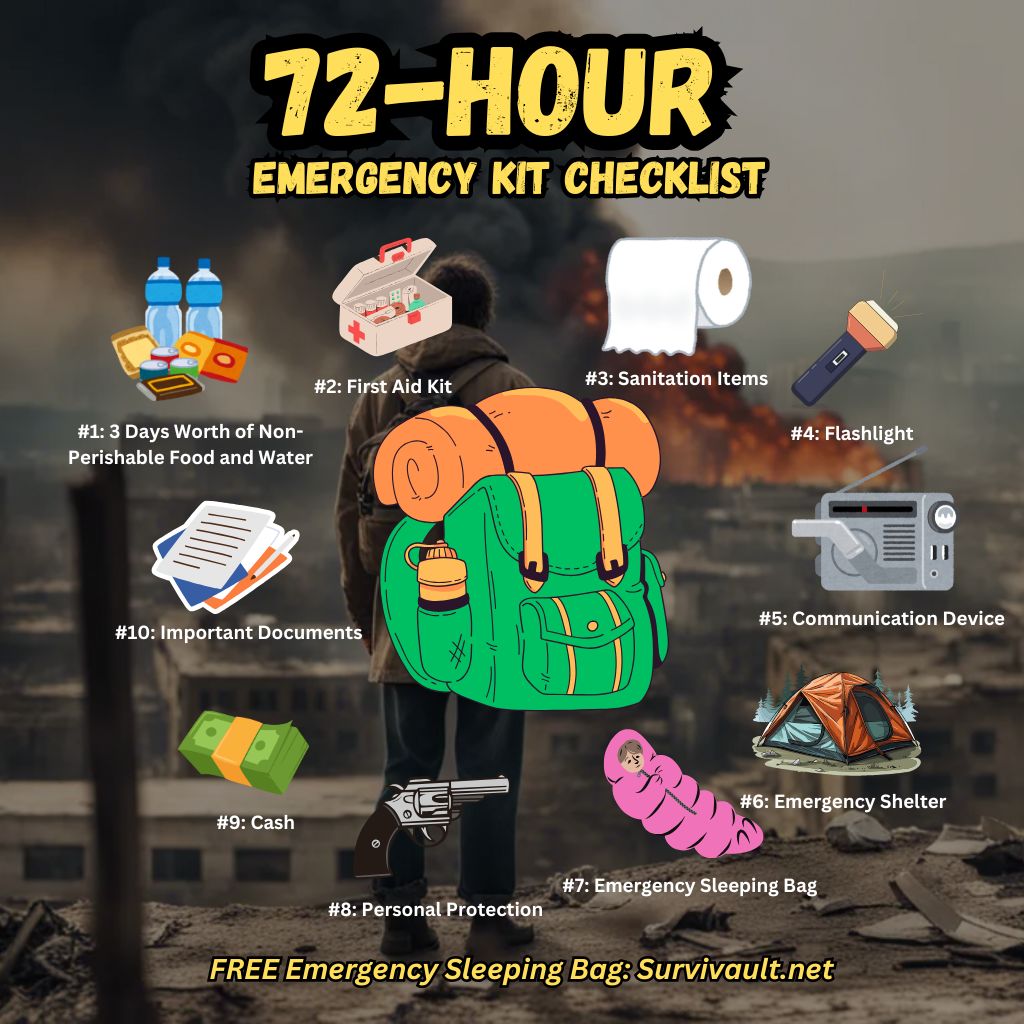
An effective 72-hour emergency kit has many supplies key for survival in a disaster.
The kit must have everything necessary for you to sustain yourself and your family during the critical first days of a disaster.
In an urban setting, these emergency supplies should cover basic needs such as food, water, shelter, communication, and first aid.
By preparing ahead of time and tailoring your kit to your specific needs, you can face any situation with confidence.
Below are the essential supplies to include in your 72-hour emergency kit:
Water and Food
Water is the most crucial item in your 72-hour emergency kit, as the body can’t survive long without it.
Ideally, pack one gallon of water per person per day, which accounts for drinking and basic hygiene needs.
In cities, water supplies can be disrupted quickly by power outages or infrastructure damage, so having clean, drinkable water on hand is essential.
Consider adding water purification tablets or a portable water filter as well, in case you need to source water from a nearby river or public fountain.
Food is another high-priority item.
Opt for non-perishable, ready-to-eat meals like canned goods, energy bars, and freeze-dried options.
Choose items that are easy to prepare and have a long shelf life, so you don’t need to rotate them too often.
Don’t forget a manual can opener, as power outages could make electric kitchen tools useless.
Additionally, pack foods that fit your dietary needs and consider comfort foods to boost morale during a stressful situation.
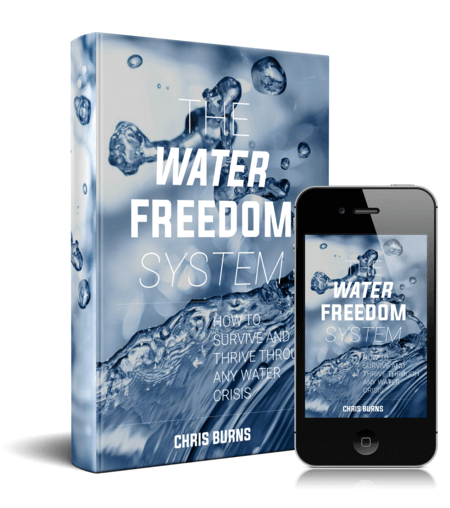
How to safe $$$ by creating your own water supply!
EXCLUSIVE step-by-step guide showing you EXACTLY how to create your own “home oasis” TODAY…and how to survive any tough century long drought…
First Aid and Hygiene Items
In any emergency, injuries are a real possibility, so a well-stocked first aid kit is a must.
Your kit should include essentials like bandages, antiseptic wipes, gauze, adhesive tape, pain relievers, and any prescription medications you or your family members might need.
Don’t forget to include medical items tailored to urban scenarios, such as burn ointment for potential fire-related injuries or a splint for potential fractures.
A basic medical guide can also help if professional medical care isn’t immediately available.
Sanitation
Sanitation is one of those survival supplies that people often overlook.
Basic hygiene can prevent illness in the aftermath of a disaster.
Pack items like hand sanitizer, wet wipes, and soap to keep yourself clean, especially if water is limited.
Consider a small portable toilet solution, as urban infrastructure may be unusable. Trash bags, plastic ties, and paper towels are also useful for managing waste and staying sanitary.
Flaslights
Flashlights are essential part of any survival kits for navigating in the dark, especially in power outages that are common in urban areas.
Consider headlamps for hands-free lighting, and pack glow sticks as backup light sources.
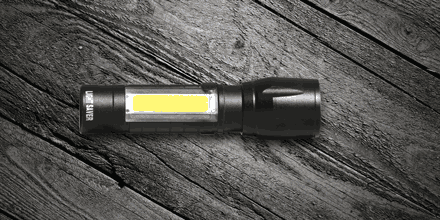
FREE Ultra BRIGHT Light Saver Tactical Torch!
Click the button below to claim your FREE Light Saver Tactical Torch!
Emergency Communication Devices
When disaster strikes, staying informed and connected is crucial.
A battery-powered or hand-crank radio will keep you updated on emergency broadcasts, while a fully charged portable phone charger will ensure you can communicate with family and emergency responders.
Make sure to also pack portable power sources for all emergency communication devices that need them.
Portable power sources keep your devices charged when power is out. Having several power banks and extra batteries means your phone stays on during emergencies.
Shelter and Warmth
Your kit should provide you with emergency shelter and warmth, especially in the event of an evacuation or if your home becomes uninhabitable.
A lightweight emergency blanket, sleeping bag, or bivvy sack can help keep you warm, even if you’re stuck outdoors.
Ponchos or rain gear are equally important, as city streets can quickly flood during storms, leaving you exposed to the elements.
You might also include a small tent or tarp for added protection if you have to create a temporary shelter.
Tools and Personal Protection
A multitool or Swiss Army knife is a valuable addition to your emergency kit, allowing you to handle various tasks, from cutting rope to opening cans.
Urban areas can become hazardous quickly, so include sturdy gloves and protective masks to guard against broken glass, debris, and air pollution.
If personal security is a concern, consider adding self-defense tools such as pepper spray. Ensure any tools or items you carry are legal and appropriate for your city’s regulations.
Important Documents and Cash
Losing vital documents can create unnecessary headaches and delays when you need to access healthcare or file claims.
Imagine standing in a long line, desperate to get aid, only to realize you don’t have proof of identity or insurance.
Store copies of important documents in waterproof pouches, making them easy to grab at a moment’s notice.
This ensures you have everything you need to navigate the immediate aftermath of a disaster without unnecessary stress.
Cash is equally important, as credit card systems and ATMs might be down during power outages.
Store small denominations for ease of use in emergency situations where digital transactions are impossible
72-Hour Emergency Kit for Pets
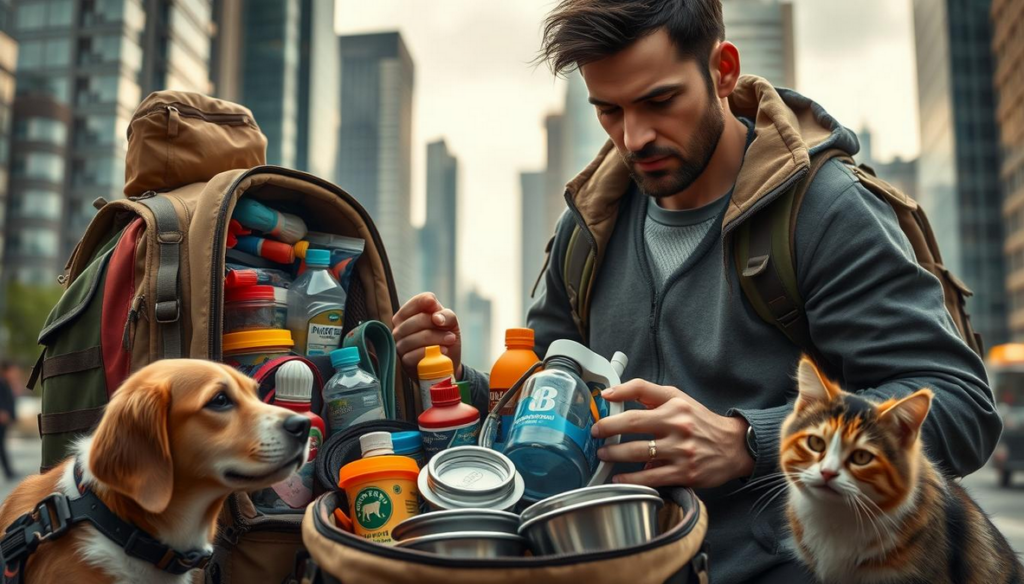
If you have pets, you surely do not want to leave them alone during emergency.
For pet owners, a 72-hour emergency kit for pets is key to disaster preparedness. It should have enough food and water for three days, based on each pet’s needs.
Important items for the kit include medications, leashes, and pet carriers.
Pre-packaged first aid kits for pets make preparing easier and are found at pet stores.
For reptiles, remember to pack lights and misters to keep them healthy in an emergency. Birds and pocket pets need ID with contact info to help find them if they get separated.
When moving out, use secure crates or enclosures for pets to prevent injuries. Don’t forget to pack plastic bags for cleaning up after pets.
Dogs should wear collars with ID tags and cats should have breakaway collars.
A well-organized pet emergency kit keeps pets safe and reduces stress for owners.
Customizing Your Kit for Unique Needs
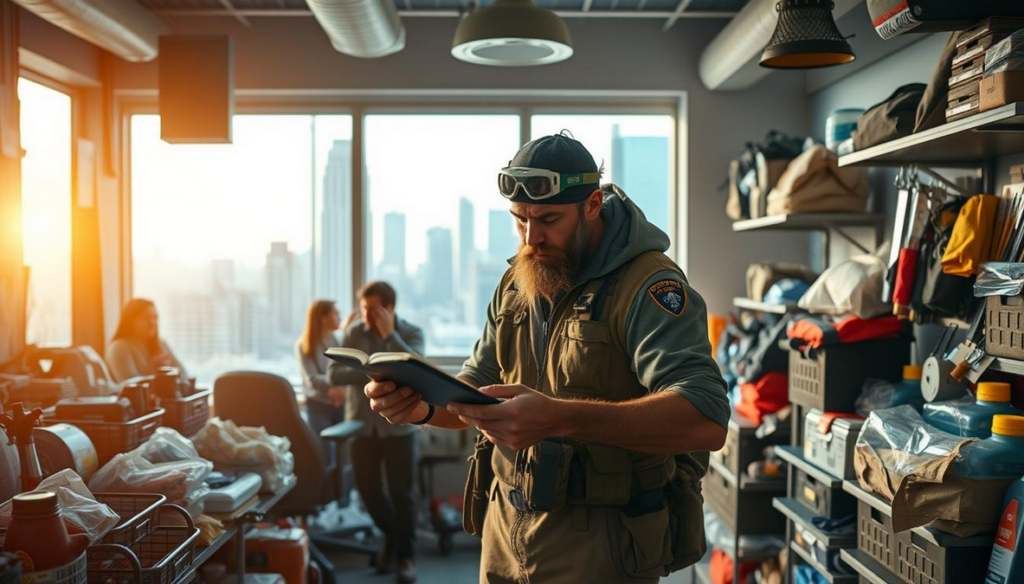
Every member of a household has his or her own needs, making it key to tailor your emergency kit.
Families should think about specific factors, especially for kids or seniors.
Knowing these differences helps with better readiness in emergencies.
Considerations for Children and Seniors
In the heart of a chaotic city, when the noise of sirens fills the air and the streets are filled with uncertainty, children and seniors face unique challenges.
As you prepare your 72-hour emergency kit, their specific needs must be front and center, because in these moments, the comfort and security you provide can make all the difference.
Imagine you’re in your apartment, and the lights flicker before plunging you into darkness. Your young child, wide-eyed, clutches their favorite stuffed animal, trying to make sense of what’s happening.
For children, the unfamiliarity and fear during a crisis can be overwhelming, so adding familiar, comforting items like toys or games to your kit is more than just a luxury — it’s a way to provide emotional stability.
A small toy, a coloring book, or even a favorite snack can bring a sense of normalcy in an otherwise frightening situation.
Don’t forget essential foods like formula for babies, or easily packed, non-perishable snacks for older children. These simple gestures can keep them calm when the world around them feels uncertain.
For seniors, the challenges are different but equally important.
You may have an elderly parent or grandparent who relies on mobility aids to move around.
The thought of navigating damaged streets or evacuation shelters without their walker or cane is a frightening prospect.
In this case, make sure your emergency kit includes any mobility aids, medications, or items that help them manage day-to-day tasks.
Seniors are more vulnerable to the elements and health complications, which is why extra blankets, a spare pair of glasses, or hearing aids with extra batteries can be lifesaving.
Beyond physical needs, both children and seniors benefit from the emotional support that preparation brings.
Just knowing that you’ve thought of their needs ahead of time can give them confidence during a crisis. It’s about fostering a sense of safety when the outside world feels anything but safe.
Prescription Medications
Picture this: You’ve evacuated to a temporary shelter, only to realize you’ve left behind your heart medication or insulin.
The stress of the situation amplifies as you scramble to find help in a crowded, overwhelmed city.
This is why having at least a three-day supply of prescription medications packed in your 72-hour emergency kit bug-out bag is non-negotiable.
Make sure to store medications in your go-bag a waterproof, clearly labeled container, and if possible, include a copy of the prescription in case you need to refill it unexpectedly.
Packing and Storing Your 72-Hour Emergency Kit
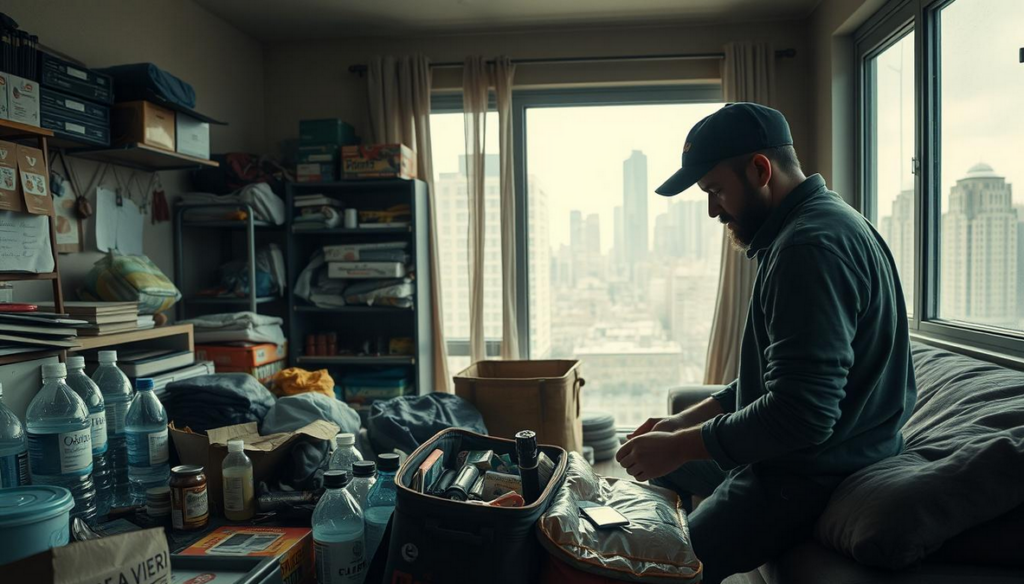
When it comes to storing your 72-hour emergency kit, strong containers are key. Backpacks, especially, are ideal for each family member’s kit.
Picture your family in a sudden evacuation scenario — the last thing you want is to be fumbling through oversized containers or boxes.
Backpacks are portable, easy to carry, and can be tailored to each person’s needs.
A backpack for your child, lightweight and filled with essentials like snacks and comfort items, is not just a bag, it’s their sense of security in a moment of chaos.
Labeling each backpack with names helps during high-pressure moments, ensuring everyone grabs their own pack quickly and without confusion.
For smaller, loose items, Ziploc bags are lifesavers.
Imagine the inside of a backpack jumbled with loose bandages, food, and hygiene products — chaos.
By using gallon-sized and jumbo Ziploc bags, you can neatly organize everything, from first aid supplies to snacks. It’s like giving order to the disorder of an emergency.
These bags keep everything in place and, just as importantly, waterproof your supplies in case of flooding or heavy rain.
You’ll know exactly where everything is when time is of the essence, minimizing stress in those crucial moments.
Maintaining and Replenishing Your Kit
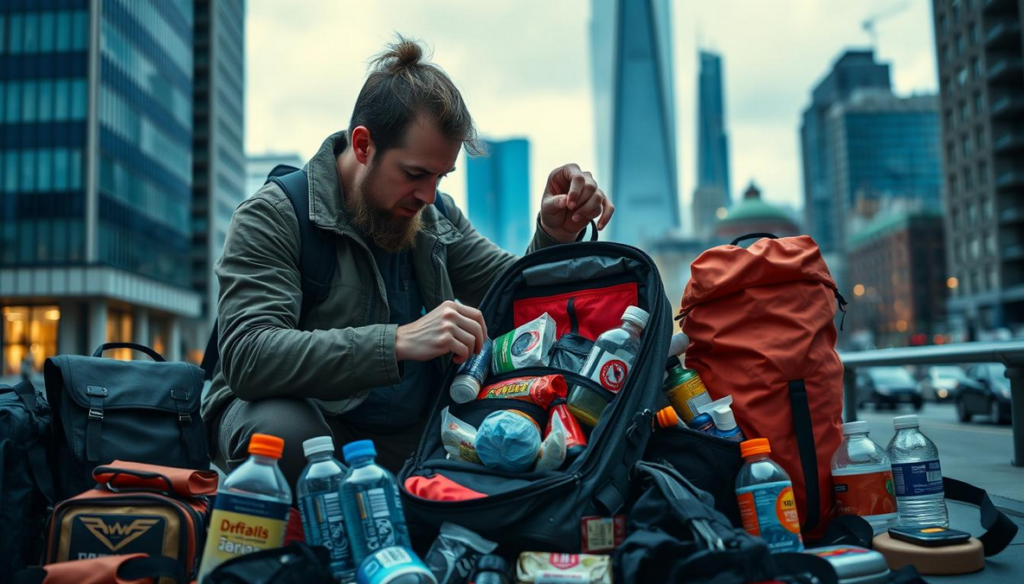
Imagine the moment of calm before a storm, the kind of stillness that can feel unsettling. You glance at the emergency kit you packed months ago and feel a sense of relief—it’s there, ready to protect your family if disaster strikes.
But then, a thought creeps in: “When was the last time I checked the kit?”
In the heat of a crisis, outdated or expired supplies could turn your lifeline into a liability. The true power of an emergency kit lies not just in packing it, but in maintaining and replenishing it over time.
Keeping your emergency kit in good shape is key to its effectiveness. You should check it often to make sure food and meds haven’t expired. This helps keep your supplies fresh and ready for any emergency.
It’s a good idea to update your emergency kit every year. This is especially true if your family’s needs change, like when kids grow or health issues arise. Updating your kit keeps you and your family safe during emergencies.
Having a list of must-have items makes restocking easier.
When preparing for emergencies, think about what you might need and make a solid plan. Getting support from others can also help you stay ready for anything that comes your way.
Conclusion
Having a 72-hour emergency kit is key for people who live in the city to be ready for disasters.
A good 72-hour emergency kit gives you peace of mind and gets you ready for the unexpected.
A 72-hour emergency kit gets you and your family ready for disasters and builds resilience.
Being ready ahead of time is the best way to protect yourself and your loved ones when disaster strikes.

